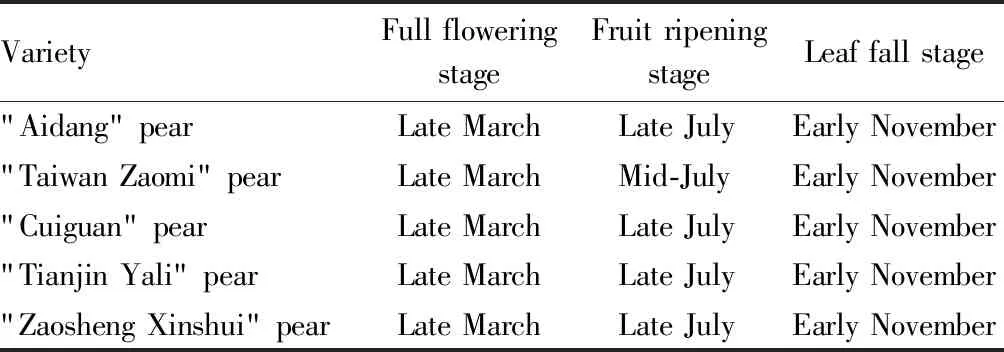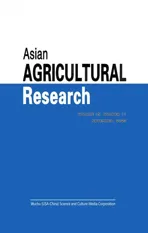Study on Adaptability of Introduced Pear Varieties
2023-12-01LianjunWANG
Lianjun WANG
Shanghai Chenshan Botanical Garden, Shanghai 201602, China
Abstract [Objectives] To study the adaptability of introduced pear. [Methods] Five pear varieties, "Aidang" pear, "Taiwan Zaomi" pear, "Cuiguan" pear, "Tianjin Yali" pear and "Zaosheng Xinshui" pear, were introduced. Then, using these five varieties, the phenology of pear trees, various characters of fruit, stress resistance (heat tolerance and cold tolerance) of varieties were studied. [Results] The plants of 5 varieties of pear trees grew fast and were robust; in late March, it went into the flowering period; "Aidang" pear fruit had a certain number of stone cells; "Taiwan Zaomi" pear had the highest sweetness; "Cuiguan" pear had the largest fruit; these five varieties of pear trees had good water resistance, heat resistance and cold resistance. [Conclusions] This study can provide a reference for the introduction of pear trees, and can also provide a practical basis for the large-scale planting of pear trees.
Key words Pear, Variety, Introduction, Adaptability, Stress resistance
1 Introduction
Pear is a deciduous shrub or small tree in thePyrusgenus of Rosaceae family, and is one of the important fruit trees in China. Pear trees are widely distributed in China, including Inner Mongolia, Shaanxi, Shandong, Zhejiang, Shanghai and Nanning. Pear trees have white flowers that appear before the leaves; pear flowers are quite amazing, and pear fruits are fresh and delicious, with high nutritional value, so it is an excellent tree species for watching flowers and eating fruits.
In recent years, there are many studies on pear trees at home and abroad, involving cultivation techniques, flowering regulation, fruit yield and other biotechnology studies[1-2]; there are some reports on the effect of fertilizer on the quality of pear trees[3]; there are also some studies focusing on pear diseases and pests[4-6]. The results of this study can not only provide a reference for the introduction of pear trees, but also provide a practical basis for the large-scale planting of pear trees.
2 Materials and methods
2.1 Overview of experimental siteShanghai Chenshan Botanical Garden Pear Specialized Area, as experimental site, is located in Songjiang District of Shanghai City on the east side of Chenshan Botanical Garden, with an annual average temperature of 15-16 ℃; the soil fertility is medium, and the soil is clay and alkaline.
2.2 Selection and collection of experimental materialsPear trees planted in the ground were selected as experimental materials, and pear resources were collected in various ways. The introduction place is mainly Shanghai. Specifically, it includes Sheshan Zhongyi Pear Garden Professional Cooperative.
2.3 Experimental design and methodsFive groups were set up in the experiment, with each pear variety as one group, and "Aidang" pear tree was used as control. When planting, five pear varieties were randomly arranged without repeated treatment. The ridge width was 200 cm, ditch width was 50 cm, and plant spacing was 250 cm.
Through the observation and research in 2019-2022, the phenological records, cold resistance, heat resistance, DBH, height and other traits of pear trees were judged by field observation, photo recording and tape measure. The DBH, height and other traits of pear trees were measured by tape measure.
3 Results and analysis
3.1 Phenological records of pear treesAs shown in Table 1, it is observed that flowers appeared before the leaves for five pear varieties, "Aidang" pear, "Taiwan Zaomi" pear, "Cuiguan" pear, "Tianjin Yali" pear and "Zaosheng Xinshui" pear, with the initial flowering period in mid-March and the full flowering period from late March to early April. "Taiwan Zaomi" pear matured at the earliest, matured one after another in mid-July, and the other four pear varieties matured one after another in late July. These five varieties of pear finished defoliation in early November.

Table 1 Phenological records of pear varieties
3.2 Characters of pear varietiesAs shown in Table 2, the height of "Taiwan Zaomi" pear was 185 cm; the plant height of "Aidang" pear, "Cuiguan" pear, "Tianjin Yali" pear and "Zaosheng Xinshui" pear was 200-215 cm; in terms of DBH of plants, the DBH of "Taiwan Zaomi" pear was 8 cm; the DBH of other four pear varieties was 11-15 cm; in terms of pulp color, the pulp color of these five varieties of pear was white; in terms of fruit sweetness, "Taiwan Zaomi" pear had the highest sweetness, and "Cuiguan" pear, "Tianjin Yali" pear and "Zaosheng Xinshui" pear had sweet fruits; however, "Aidang" pear contains more stone cells and lower sweetness. In terms of single fruit weight, the weight of "Taiwan Zaomi" pear was 100 g and the weight of "Aidang" was 160 g; the single weight of "Zaosheng Xinshui" pear was 165 g; the weight of Tianjin Yali pear was 150 g; the single weight of Cuiguan pear was 170 g.

Table 2 Characters of pear varieties
3.3 Adaptability of pear varietiesAs shown in Table 3, it is observed that five pear varieties, "Aidang" pear, "Taiwan Zaomi" pear, "Cuiguan" pear, "Tianjin Yali" pear and "Zaosheng Xinshui" pear, grew well in Shanghai, and the plants grew healthily without freezing damage in winter; it can tolerate the high temperature of 41 ℃ in summer; pear trees grew well in rainy season, and there was no obvious waterlogging.

Table 3 Adaptability of pear varieties
4 Discussion
There are many factors affecting the fruit yield of pear trees, and it is closely related to cultivation techniques. In terms of fertilization, rational fertilization should be achieved, that is, applying base fertilizer for one time and applying topdressing for two times. After leaves fall in winter, base fertilizer should be applied once. In addition to base fertilizer, topdressing can be applied once before flowering. Flowering needs to consume a lot of energy and nutrition, and topdressing should be applied after flowering. Generally, compound fertilizer can be used, and it has fast fertilizer efficiency and can be used for fruit setting and fruit enlarging quickly. In terms of pruning, pear trees can be pruned once after leaves fall to remove overgrown branches and tillering branches. Over-dense branches should be thinned, long branches should be cut short, and the pruned tree shape should be paid attention to at the same time.
In terms of diseases and pests, pear trees have some common diseases and pests, such as aphids, pear rust, oriental fruit moth,etc., which need timely prevention and control. In addition, there is the destruction caused by squirrels and birds. When pears are about to mature, they will be eaten by squirrels and birds, which need to be controlled by bird-proof nets. Otherwise, the fruit will be greatly reduced.
杂志排行
Asian Agricultural Research的其它文章
- Requirements and Safeguard Measures for Using Soil Fertilizer in Organic Agriculture: A Case Study of Fushun City in Liaoning Province
- Intellectual Property Protection, Inheritance, Innovation and Development of Woody Edible Oilseeds in Hubei Province
- Pesticide Residue Content in Vegetable Bases of Lhasa City
- Measurement of Digital Economy Development Level in Yangtze River Delta and Its Influence on Ecological Efficiency
- Current Implementation and Experience of Natural Farming in Japan
- Teaching Reform of Fundamentals of Combustion for Energy and Power Engineering Majors in Agricultural Colleges and Universities in the Context of New Engineering Course
